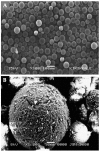Molecularly Imprinted Polymers for Removal of Metal Ions: An Alternative Treatment Method
- PMID: 31105259
- PMCID: PMC6352701
- DOI: 10.3390/biomimetics3040038
Molecularly Imprinted Polymers for Removal of Metal Ions: An Alternative Treatment Method
Abstract
Aquatic and terrestrial environment and human health have been seriously threatened with the release of metal-containing wastewater by the rapid growth in the industry. There are various methods which have been used for removal of ions from the environment, such as membrane filtration, ion exchange, membrane assisted liquid extraction and adsorption. As a sort of special innovation, a polymerization technique, namely molecular imprinting is carried out by specific identification for the target by mixing it with a functional monomer. After the polymerization occurred, the target ion can be removed with suitable methods. At the end of this process, specific cavities, namely binding sites, are able to recognize target ions selectively. However, the selectivity of the molecularly imprinted polymer is variable not only because of the type of ligand but also charge, size coordination number, and geometry of the target ion. In this review, metal ion-imprinted polymeric materials that can be applied for metal ion removal from different sources are discussed and exemplified briefly with different metal ions.
Keywords: ion imprinting; metal pollution; metal removal; molecularly imprinted polymers.
Conflict of interest statement
The authors declare no conflict of interest.
Figures








Similar articles
-
Pressure-Stable Imprinted Polymers for Waste Water Remediation.Polymers (Basel). 2018 Jun 26;10(7):704. doi: 10.3390/polym10070704. Polymers (Basel). 2018. PMID: 30960629 Free PMC article.
-
The binding of metal ions to molecularly-imprinted polymers.Water Sci Technol. 2017 Apr;75(7-8):1643-1650. doi: 10.2166/wst.2017.036. Water Sci Technol. 2017. PMID: 28402305
-
Ion-Imprinted Polymeric Materials for Selective Adsorption of Heavy Metal Ions from Aqueous Solution.Molecules. 2023 Mar 20;28(6):2798. doi: 10.3390/molecules28062798. Molecules. 2023. PMID: 36985770 Free PMC article. Review.
-
Preparation of a novel molecularly imprinted polymer for the highly selective extraction of baicalin.J Sep Sci. 2015 Dec;38(24):4233-9. doi: 10.1002/jssc.201500865. Epub 2015 Nov 16. J Sep Sci. 2015. PMID: 26459994
-
Application Prospect of Ion-Imprinted Polymers in Harmless Treatment of Heavy Metal Wastewater.Molecules. 2024 Jul 2;29(13):3160. doi: 10.3390/molecules29133160. Molecules. 2024. PMID: 38999112 Free PMC article. Review.
Cited by
-
Adsorptive Membrane for Boron Removal: Challenges and Future Prospects.Membranes (Basel). 2022 Aug 18;12(8):798. doi: 10.3390/membranes12080798. Membranes (Basel). 2022. PMID: 36005713 Free PMC article. Review.
-
Application of Molecularly Imprinted Polymers in the Analysis of Waters and Wastewaters.Molecules. 2021 Oct 28;26(21):6515. doi: 10.3390/molecules26216515. Molecules. 2021. PMID: 34770924 Free PMC article. Review.
-
Three-Dimensional Printing of Molecularly Imprinted Polymers by Digital Light Processing for Copper Ion Sequestration.3D Print Addit Manuf. 2024 Apr 1;11(2):e619-e627. doi: 10.1089/3dp.2022.0107. Epub 2024 Apr 16. 3D Print Addit Manuf. 2024. PMID: 38689897 Free PMC article.
-
Preparation of cholesterol-imprinted polymer for selective adsorption of cholesterol from gastrointestinal mimicking solution.Turk J Chem. 2024 Feb 7;48(2):387-401. doi: 10.55730/1300-0527.3666. eCollection 2024. Turk J Chem. 2024. PMID: 39050507 Free PMC article.
-
Synthesis and Study of Sorption Properties of Zinc-Imprinted Polymer.Polymers (Basel). 2024 Dec 19;16(24):3545. doi: 10.3390/polym16243545. Polymers (Basel). 2024. PMID: 39771397 Free PMC article.
References
-
- Ihsanullah, Abbas A., Al-Amer A.M., Laoui T., Al-Marri M.J., Nasser M.S., Khraisheh M., Atieh M.A. Heavy metal removal from aqueous solution by advanced carbon nanotubes: Critical review of adsorption applications. Sep. Purif. Technol. 2016;157:141–161. doi: 10.1016/j.seppur.2015.11.039. - DOI
-
- Hashemian S., Saffari H., Ragabion S. Adsorption of cobalt(II) from aqueous solutions by Fe3O4/bentonite nanocomposite. Water. Air. Soil Pollut. 2015;226:2212. doi: 10.1007/s11270-014-2212-6. - DOI
-
- Morsi R.E., Al-Sabagh A.M., Moustafa Y.M., ElKholy S.G., Sayed M.S. Polythiophene modified chitosan/magnetite nanocomposites for heavy metals and selective mercury removal. Egypt. J. Pet. 2018 doi: 10.1016/j.ejpe.2018.03.004. - DOI
-
- Jalilzadeh M., Uzun L., Şenel S., Denizli A. Specific heavy metal ion recovery with ion-imprinted cryogels. J. Appl. Polym. Sci. 2016;133:1–9. doi: 10.1002/app.43095. - DOI
Publication types
LinkOut - more resources
Full Text Sources
Research Materials

